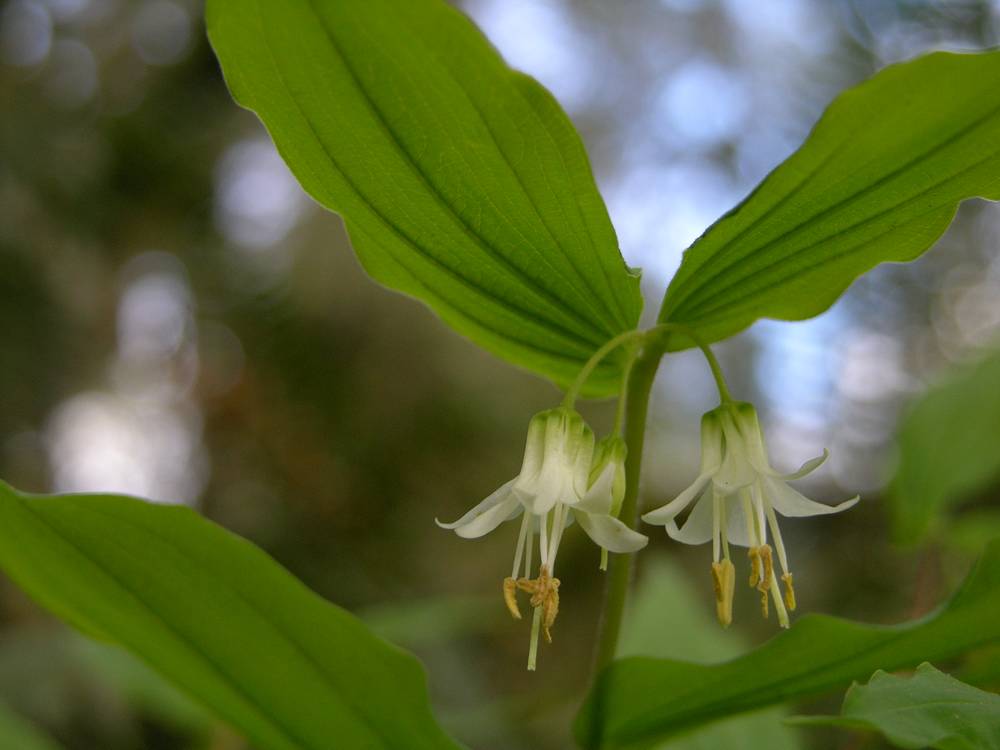Written By: Anne Ternes
- Scientific Name: Prosartes hookeri or Disporum hookeri
- Canopy Layer: Ground Cover
- Attracts: Pollinators and Birds
- Portland Plant List: Yes!

Drops of gold and Hooker’s fairy bells are apt names for this lily that grows in the shade of trees, often surrounded by water. The kind of place you picture in a fairytale, where the hero must go in search of gold or seek the advice of the fair folk. And while this description may bring to mind a low-to-the-ground herb with dainty flowers, drops of gold is anything but. A medium perennial drops of gold reaches up to three feet in height, supported by solid and woody stems that bear large, deeply veined leaves and creamy, bell-shaped flowers.

Drops of gold grows in forest understories along the western edge of North America, from British Columbia down through California and possibly into Mexico. They have crept slightly east, having been found in Idaho, Montana, and even Michigan, though it is unclear if the species in Michigan is the same as our native fairy bell. No matter the state they are in, the understory is where drops of gold are at home and where they wish to stay, enjoying partial or no sun and moist soils. They are often found growing alongside wood ferns, maidenhair ferns, and false Solomon’s seal. Consider adding drops of gold to a fern garden, as ground cover under a tree, along a shaded waterway, or a shaded edge of a pollinator meadow.

Drops of gold, lying low amongst its similarly colored friends, can be an easy plant to miss as you walk through the woods. Younger plants are low to the ground and have a light green color in their stems and leaves. As they mature, the leaves darken, the veins become more pronounced, and the stems become woody, developing a greenish-bronze color that looks like a pipe channeling something up from the ground. The stems taper off at the end, where white, bell-shaped flowers bloom in the spring, attracting numerous pollinators before developing into hanging, yellow-green berries, looking like drips from a pipe. The rotund berries develop as summer ends, darkening from yellow-green to orange and red. At which point, they are readily consumed by finches, chickadees, sparrows, crows, and jays.

Drops of gold is a ground cover plant, setting it in the lowest-lying vegetation layer. Ground cover plants help reduce soil erosion by creating a barrier between soil and elements such as wind and rain. Drops of gold additionally help prevent soil erosion by anchoring soil with its rhizome root system, reducing the likelihood the soil will be washed or blown away. This tall ground cover plant also protects small mammals and birds that forage on the ground. The flowers of drops of gold are a favorite of many insect pollinators, including multiple native bee species, while the fruit is a favorite food source for birds in the late summer and early fall.

Wanting some whimsy in your shade garden? Drops of gold has you covered and is available at select local nurseries. Be sure to check the species name on your plant. P. hookeri and P. smithii are our native fairy bells. Plant your drops of gold in spring or summer, when it will receive plenty of water and in an area that receives at least some shade. Once established, drop of gold requires very little maintenance, just some pruning if it outgrows your space and possibly some water in the dry months. And with that, you’ll have a beautiful addition to any shaded area that your local birds and pollinators will thank you for.
Sources:
- “Hooker’s Fairy Bell.” calspace.org. California Native Plant Society. https://calscape.org/loc-California/Prosartes%20hookeri%20(Hooker’s%20Fairy%20Bell)?newsearch=1
- “Prosartes hookeri.” Native Plants Database. Audubon. https://www.audubon.org/native-plants/search?zipcode=97203&active_tab=full_results&attribute=&attribute_tier1=&resource=&resource_tier1=&bird_type=&bird_type_tier1=&page=1&page_tier1=1
- Stanley, Gerald B. “Prosartes hookeri.” wnps.org. Washington Native Plant Society. https://www.wnps.org/native-plant-directory/456-prosartes-hookeri